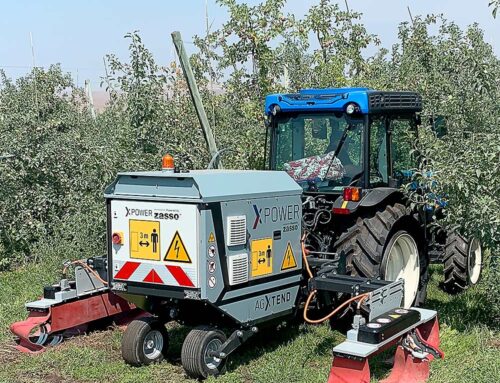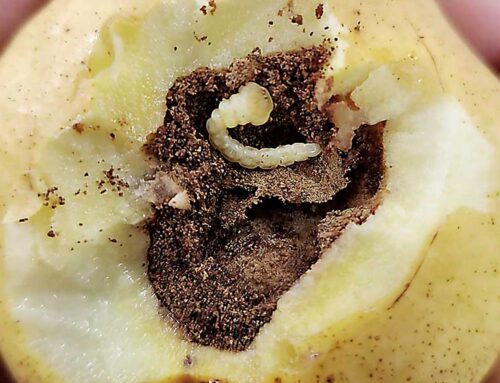Since 2010, sweet cherry growers in Washington have found an increased incidence of trees showing undersized and unmarketable fruit at ripening time.
Widespread infection of cherry trees with the agent or agents causing this condition known as little cherry disease (LCD) has growers concerned about the extent of economic damage to their orchards and how long this outbreak will last.
How the infection spreads among trees has not been fully investigated although insect vectors, i.e., leafhoppers and mealybugs, have been implicated.
While more information is sought on this disease, growers are advised to remove infected trees and manage insect populations with broad-spectrum insecticides. Unfortunately, these treatments often kill non-target insects and beneficial organisms.
Little cherry disease can be caused by little cherry virus 1 (LChV1) and/or little cherry virus 2 (LChV2). Western X disease, caused by a specialized bacteria named Western X phytoplasma (WX), is a related disease.
LChV2 is transmitted by mealybugs, and WX is known to be vectored by leafhoppers.
A 2014 study conducted by Washington State University’s Clean Plant Center Northwest (CPCNW) showed that LChV2 was the most prevalent pathogen detected in cherry samples showing symptoms of LCD, followed by WX. LChV1 was rarely found and was always in co-infection with LChV2 or WX.
With Western X phytoplasma infection, symptoms include fruit that is undersized, light pink or strawlike in color, and bitter in taste.
Red and light pink cherries may be seen in the same bunch. Symptoms develop slowly; a tree infected in late summer may not show symptoms until the next summer or fall.
Cherry trees on Mahaleb rootstocks are particularly sensitive to WX infection and will typically decline rapidly within one to two seasons of the initial infection.
Some notably different symptoms seen with infection by LChV1 and LChV2 include premature fall coloration in certain cultivars (Canindex 1), and late-ripening and flavorless fruit.
In Washington, Western X disease was first reported in peaches at the 1940 Washington State Horticultural Association meeting and in cherries at the 1946 meeting.
Work done in the early 1950s at what was then called the Tree Fruit Experiment Station in Wenatchee, Washington, determined that only certain leafhoppers were capable of transmitting the pathogen from fruit tree to fruit tree.
Studies conducted by Washington and Idaho scientists showed that the geminate leafhopper (Colladonus geminatus) and the cherry leafhopper (Fieberiella florii) were capable of transferring WX from infected cherry to healthy peach trees.
The success of WX transmissions was based solely on symptoms expressed in recipient plants that had become infected through feeding by leafhoppers with WX.
Since the 1960s, little attention has been paid to the role of leafhoppers in the transmission of WX in Washington cherries.
In California, where Western X disease is more prevalent, many studies on leafhoppers transmitting WX have been accomplished.
California’s WX disease model involves two kinds of leafhoppers: the mountain leafhopper (Colladonus montanus) and the cherry leafhopper.
The mountain leafhopper overwinters on winter annual weeds near waterways, and in early springtime, moves on to orchard floor weeds.
While the mountain leafhopper is very abundant in California cherry orchards, it does not reproduce on cherries, preferring instead to inhabit orchard floor weed hosts, flying up occasionally to feed on cherry leaves.
The mountain leafhopper is believed to introduce WX phytoplasma from wild plant hosts into a cherry orchard. The cherry leafhopper, which does reproduce on cherry, is known to pick up the phytoplasma from an infected tree and carry it to another tree nearby.
Last summer and fall, Dr. Dan Villamor, research associate with the CPCNW, and I monitored leafhopper activity in cherry orchards in Yakima, Benton, Grant, Douglas and Chelan counties.
Dr. Andrea Bixby-Brosi, research associate at WSU’s Tree Fruit Research and Extension Center, monitored leafhopper abundance at three sites in Chelan County as well.
Considering only those that potentially vector WX, the most abundant species found statewide were Colladonus reductus (no common name) and Colladonus geminatus, the geminate leafhopper. C. reductus is considered a candidate WX vector as it bears a close resemblance to the mountain leafhopper.
No mountain leafhopper was found in any Washington orchard. In late September, a population of cherry leafhoppers was found in one organic orchard in Chelan County. We found one cherry leafhopper in late October in a conventional cherry block in Yakima County; no other conventional orchard had this species.
Molecular diagnostic testing was accomplished on leafhopper samples from 2015. DNA was extracted from either a single specimen or a pooled sample of several specimens.
Using PCR (polymerase chain reaction), we probed these leafhopper samples for a short piece of a gene that is very specific to Western X phytoplasma.
We found many samples positive for WX from three potential vector species: the geminate leafhopper, the cherry leafhopper, and C. reductus. However, finding leafhoppers positive for WX does not label them as vectors; transmission experiments demonstrating that a leafhopper can pick up WX from a donor plant and introduce it into a recipient plant need to be done for proof.
We received grant funds from the Washington Tree Fruit Research Commission to continue this work. Beginning this spring, we will monitor leafhopper traffic with yellow sticky cards placed in the orchard and in the habitat adjacent to the orchard (typically sageland).
Orchard floor vegetation will be sampled using sweep nets. In addition, we will assess the potential of certain plant species to serve as hosts for WX and/or leafhoppers. Transmission experiments will be conducted to verify the vector potential of certain leafhoppers.
Targeting all leafhoppers with insecticide sprays when only one or two species are culprits is not economically justified. By updating and expanding our knowledge of the roles that leafhoppers play in the transmission of Western X disease, we can begin to move toward a sustainable, more targeted approach to leafhopper management in cherries. •
– by Dr. Holly Ferguson, a research associate with Clean Plant Center Northwest at Washington State University’s Prosser research station in Prosser, Washington.






From Dr. Holly Ferguson: Thank you for posting this article online. A point of clarification: the leafhoppers pictured with this online article are NOT found in cherry orchards. These two leafhoppers are the main pest species in Washington wine grapes: the Virginia Creeper Leafhopper and the Western Grape Leafhopper. In cherries, the two main kinds of leafhoppers that we are studying as potential carriers of Western X are Colladonus reductus and C. geminatus. For a picture of these leafhoppers and more information, please visit the Clean Plant Center Northwest Facebook page (http://www.facebook.com/cleanplantcenter ).
Holly, thank you for that clarification!